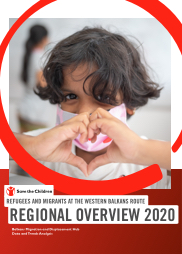
Study: Research
Balkans Migration and Displacement Hub Data and Trend Analysis: Refugees and migrants at the Western Balkans Route regional overview 2020
Publication year:
2021
English
Format:
pdf (2.6 MiB)
Publisher:
Save the Children International,Save the Children North West Balkans
Data and Trend Analysis (DATA) Refugees and Migrants at the Western Balkans Route Regional Overview 2020 is an annual report, describing key trends in migrations in the region in 2020, detailing information about the number of people on the move, demography (age, sex, country of origin, etc), behavioral patterns, and routes in use – with a focus on children, particularly unaccompanied children.
Key trends showcased in this report:
- While the beginning of 2020 was marked by an increase in the number of new refugee and migrant arrivals to the Balkans, the figures significantly decreased once the COVID-19 pandemic started. Until the end of the year, around 16,000 new refugee and migrant entries were officially registered, amounting to one-fifth of the arrivals registered in 2019.
- Although fewer children and adults entered Greece, the key entry point on the Western Balkans Route, the migration movement within the region remained high. Those stranded in the Balkans countries moved regardless of the pandemic, trying to reach one of their destination countries in Western Europe.
- Despite the decreased number of new arrivals and continued movement through the region and towards Western and Central Europe, around 140,000 refugees and migrants were present in the countries along the route at the end of 2020, which is an increase compared to the beginning of the year when around 128,000 people on the move were reported staying in the reception centres.
- Children made up about one-third of all refugees and migrants transiting through the Balkans, with the majority of them being unaccompanied and separated children.
- The transit routes changed somewhat since the beginning of the pandemic, with the route through Romania emerging.
- Bosnia and Herzegovina remained a key country on the route for refugees and migrants traveling through the Balkans. The country has been struggling to provide accommodation and support to the high number of people already present, with more continually arriving. The situation worsened after the authorities closed one of the major accommodation facilities in September, leaving thousands of refugees and migrants to sleep in the open.
- The majority of unaccompanied and separated children in the Balkan countries were boys from Afghanistan and Pakistan. Children from African countries and Syria were also registered as unaccompanied travelers.
Read full abstract
Authors
View & Download
Document information
Authors
Format
Content type
Country
Region
Topics
Rights
© Author/Publisher
Found a mistake? Help us improve!
If you have noticed a document assigned to the wrong author or any other inaccuracies, let us know! Your feedback helps us keep our data accurate and useful for everyone.
Share
Link
